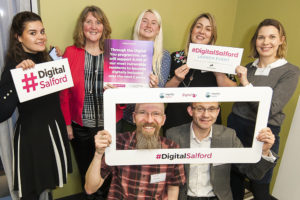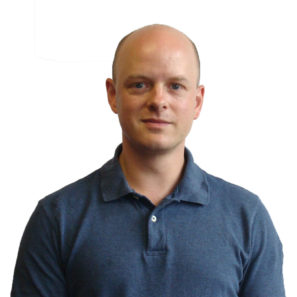A place of welcome
Our Research Manager, James Richardson, talks about his visit to St James Church, one of our new Online Centres joining us as part of the Digital You project which aims to get more Salford residents online.
On a map of the national Indices of Deprivation data, St James church sits at the north end of the thick band of red that covers three-quarters of Greater Manchester, all the way round from east to south. The deeper the shade of red, the greater the deprivation. St James is located in one of the darkest areas: the neighbourhood is among the 2% most deprived in England.

St James is a typically nondescript Victorian inner city church: red brick, tile roof, no tower or steeple. Almost fifty years ago, most of the north aisle was divided from the nave with a wall and a roof, to form a single long room, completely separate from the area for worship. The room doesn’t appear to have changed much since: it’s a little rough around the edges, but has a comfortable feeling that will be familiar to anyone who has ever entered a church hall, scout hut or similar English institution. At one end of the room, there are two plug sockets. Trailing wires along the walls lead to adaptors which power all of the appliances in the tiny kitchen area, the fridges and freezer where perishable items for a food bank are stored, a wireless router, computers – everything.
Three mornings a week the room is open as a ‘Place of Welcome’. A hot lunch is free to all attendees, to avoid drawing a distinction between those who can and cannot afford it. The food bank – supplied by FareShare and donations from local supermarkets – charges shoppers £2.50 to fill a basket. When I visit the church on a blustery morning in March the space is busy, and the tables along one side of the room are full. Two men in their eighties, Polish and Italian, are chatting over cups of industrial-strength tea. A woman tries valiantly to keep her two year-old son entertained, quiet and in his pushchair, but he is having none of it. Further down the tables a man is on Facebook, showing others a picture of his daughter, newly enrolled in college; later on he breaks down in tears, as he recounts the death of his mother.
Next to the makeshift counter of the food bank, two large laptops share a small square table that is barely big enough to accommodate them back-to-back; you can’t open one screen more than ninety degrees, without having to reduce the angle of the other. Richard – whose role as a volunteer includes but is not limited to being an IT tutor – is helping a woman in her fifties to find a new home on a housing association website. She is living in the three bedroom home where she raised her two children, and can no longer afford the bedroom tax. When Richard is busy with other things, I sit down with her. She cannot use a computer at all, she explains, so together we look at pictures of the property and Google Maps of the local area. She says that she wants to visit the property and take a look at it from the outside, so I write down the address for her. She thanks me profusely. I find out later that she cannot read.
Leading me through a door at the far end, the warden shows me the church proper. It is four or five times the size of the community room and is silent and empty, apart from the few food bank items that mice cannot gnaw into. The boxy exterior of the community room sits rather awkwardly along one wall. The warden explains that, although weekly congregations are not large, they are reluctant to give over any more floor space to community activities. Recently several local young people have been killed in knife attacks; for these and other local deaths, funerals have filled the church to capacity.
There are plans to expand the community space, which are only awaiting approval of funding from the diocese. The current room was built with floor joists in the ceiling, so it can easily be converted into the bottom half of a two-storey space (that won’t cut into the rest of the church), with an accessible lift, and refurbishment including more desperately needed power outlets. The upper room would be dedicated to learning. When we go back into the community room we find that learning is, in fact, already happening: three retired women are sitting with Richard around a table, with phones, tablets, and tea.
St James is part of the network of newly-inaugurated Online Centres in the Digital You project, which aims to get more Salford residents online. The City of Salford has some of the highest levels of digital exclusion in the UK – 23% of adults lack one or more basic digital skills – correlated with pockets of high social exclusion: poverty, unemployment and disability. Digital You is about reaching out to these people in their communities and helping them engage with digital in ways that can improve their lives.
This is an important programme, both within Greater Manchester and nationally. Salford City Council have recognised the need for innovation and partnership in digital inclusion and should be commended for breaking new ground.
I have been to a lot of Online Centres in my time, but never one quite like St James. Poverty and disadvantage were not only visible, they were impossible to ignore, and almost overwhelming. At the same time, the atmosphere was absolutely egalitarian, warm, and open. Nobody questioned my presence, and everybody talked without reserve or embarrassment about life and its challenges. The boundary between helped and helper was almost invisible. Here was a place of social resources, that could and did welcome anybody.
When we talk a lot about the strengths of the Online Centres network, we often use words like informality, friendliness, understanding, trust; it’s hard to imagine a place that offers these things as much as St James manages to do. It is exactly the kind of organisation we need in the Network, exactly the kind of place where we can embed digital inclusion alongside other support services.
Confronted with such an obvious problem being met with such an effective solution, my first instinct was to offer help. Could I wash up? No, thank you – the volunteers had that covered. Serve food? They’d rather I didn’t – they’d just had a Food Hygiene refresher and it wasn’t good practice. Buy something for the food bank? They did pretty well for donations, they explained, although they’d love to be able to serve people proper coffee, and were running out of size five nappies…I ran across the road to Asda, and came back with a couple of bags.
The one thing that seemed completely inappropriate was to tell them what they should be doing. They knew exactly what they needed to do. Their digital skills support was only just getting off the ground and was poorly equipped, but was already helping to address the needs of people facing levels of social exclusion which are outrageous in 21st century Britain. Asking them about hitting targets and achieving KPIs, the usual language of programme delivery, would have felt wildly out of place. They want to become a centre for digital learning – that’s the only target that matters. We should be helping them to reach it, and helping them to measure their progress towards it as easily as possible. Anything else is just getting in the way.
As well as the incredible work of organisations like St James, the Digital You programme is made possible by Surriya Walters, our Outreach Manager on a whirlwind trip across the Borough. I’ve only visited St James the once; I’m just a tourist. But Surriya visits our delivery partners across Salford every day, to see firsthand the energy and passion poured into socially inclusive projects and the impact these are having. As well as helping individual organisations, she is also helping them to communicate with and support each other, knitting the network together to improve pathways of support for the people of Salford. Her passion, and her presence on the ground, are what’s making Digital You a success.

James Richardson
Research Manager
James is part of our small team of talented people who carry out research and evaluation, making sure that Good Things Foundation always knows what's going on in its network and how we can help, as well as forming partnerships with a broad range of research partners.
